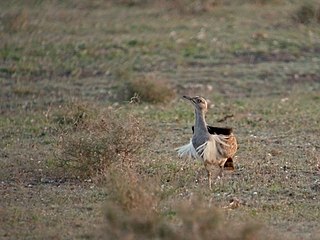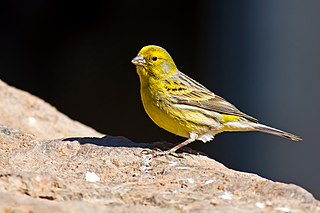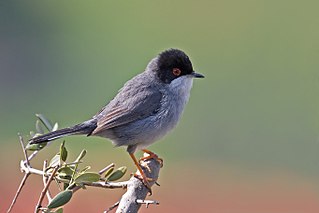 W
WThe corn bunting is a passerine bird in the bunting family Emberizidae, a group now separated by most modern authors from the finches, Fringillidae. This is a large bunting with heavily steaked buff-brown plumage. The sexes are similar but the male is slightly larger than the female. Its range extends from Western Europe and North Africa across to northwestern China.
 W
WThe Canarian houbara, Chlamydotis undulata fuertaventurae, is a large bird in the bustard family. It is a houbara bustard subspecies which is endemic to the eastern Canary archipelago, in Macaronesia in the North Atlantic Ocean, where it is a scarce and threatened non-migratory resident. It is the animal symbol of the island of Fuerteventura.
 W
WThe Canary Islands chiffchaff is a species of leaf warbler endemic to the Canary Islands, Spain. Sometimes the English name is spelled Canary Island chiffchaff.
 W
WThe Canary Islands Oystercatcher, Canarian Oystercatcher, or Canarian black Oystercatcher , was a shorebird of uncertain taxonomy endemic to Fuerteventura, Lanzarote, and their offshore islets in the Canary Islands, Spain. It is now considered to be extinct.
 W
WThe Canary Islands quail once occurred on the islands of El Hierro, La Palma, Tenerife and Fuerteventura.
 W
WThe Atlantic canary, known worldwide simply as the wild canary and also called the island canary, common canary, or canary, is a small passerine bird belonging to the genus Serinus in the finch family, Fringillidae. It is native to the Canary Islands, the Azores, and Madeira. Wild birds are mostly yellow-green, with brownish streaking on the back. The species is common in captivity and a number of colour varieties have been bred.
 W
WThe Gran Canaria blue chaffinch is a species of passerine bird in the finch family Fringillidae. It is endemic to Gran Canaria in Spain's Canary Islands.
 W
WThe Tenerife blue chaffinch is a species of passerine bird in the finch family Fringillidae. It is endemic to Tenerife in Spain's Canary Islands. This bird is the natural symbol of this island, together with the Canary Islands dragon tree.
 W
WThe laughing dove is a small pigeon that is a resident breeder in Africa, the Middle East, the Indian Subcontinent, and Western Australia where it has established itself in the wild around Perth and Fremantle. This small long-tailed dove is found in dry scrub and semi-desert habitats where pairs can often be seen feeding on the ground. A rufous and black chequered necklace gives it a distinctive pattern and is also easily distinguished from other doves by its call. Other names include laughing turtle dove, palm dove and Senegal dove while in India the name of the little brown dove is often used.
 W
WThe European turtle dove is a member of the bird family Columbidae, the doves and pigeons. It breeds over a wide area of the south western Palearctic including north Africa but migrates to northern sub-Saharan Africa to winter.
 W
WThe dune shearwater, also known as the Canarian shearwater or Hole's shearwater, was a relatively large shearwater which bred in the Canary Islands archipelago of the North Atlantic Ocean. Fossils have also been found in the Figueira Brava cave archaeological site on the western coast of Portugal. The specific epithet honours Mrs Jean Hole who collected fossil material of the species on the Jandia Peninsula of Fuerteventura. It was intermediate in size between the Manx and Cory's shearwaters. Its breeding colonies were in dune fields, in contrast to those of the smaller and sympatric lava shearwater which bred in lava fields. Extinction of the species occurred about 2000–3000 years ago, contemporaneously with the first human settlement of the islands by the Guanches, with the cause likely to be human predation.
 W
WThe eastern Canary Islands chiffchaff or Lanzarote Island chiffchaff is an extinct subspecies of the Canary Islands chiffchaff endemic to the island of Lanzarote – and possibly also Fuerteventura – in the Canary Islands, Spain.
 W
WThe trumpeter finch is a small passerine bird in the finch family Fringillidae. It is mainly a desert species which is found in North Africa and Spain through to southern Asia. It has occurred as a vagrant in areas north of its breeding range.
 W
WThe La Palma chaffinch, also known as the Palman chaffinch or, locally in Spanish as the pinzón palmero or pinzón hembra, is a small passerine bird in the finch family Fringillidae. It is a subspecies of the common chaffinch that is endemic to La Palma in the Canary Islands, a Spanish archipelago that forms part of Macaronesia in the North Atlantic Ocean.
 W
WThe laurel pigeon or white-tailed laurel pigeon is a species of bird in the Columba genus in the family Columbidae. It is endemic to the Canary Islands, Spain, and resides in laurel forest habitat. It is the animal symbol of the island of La Gomera.
 W
WThe lava shearwater, or Olson's shearwater, was a species of shearwater that bred on Lanzarote and Fuerteventura in the Canary Islands. It is known from fossil remains, and was only described in 1990. It was intermediate in size between the Manx shearwater and the little shearwater. The remains of the species are particularly common in lava fields.
 W
WThe long-legged bunting is an extinct flightless species of bunting. It was distinguishable by its long legs and short wings, and it inhabited Tenerife, one of the Canary Islands. It is one of the few flightless passerines known to science, all of which are now extinct.
 W
WThe common moorhen, also known as the waterhen or swamp chicken, is a bird species in the rail family (Rallidae). It is distributed across many parts of the Old World.
 W
WBolle's pigeon is a species of the genus Columba of family Columbidae, doves and pigeons, endemic to the Canary Islands, Spain. This bird is named after the German naturalist Carl Bolle, who was the first to distinguish it from the laurel pigeon. This wood pigeon is endemic to the laurel forest habitat.
 W
WBerthelot's pipit is a small passerine bird which breeds in Madeira and the Canary Islands. It is a common resident in both archipelagos.
 W
WThe plain swift is a medium-sized swift. Although this bird is superficially similar to a barn swallow or house martin, it is not related to those passerine species. The resemblances between the groups are due to convergent evolution reflecting similar life styles.
 W
WThe black-bellied sandgrouse is a medium large bird in the sandgrouse family.
 W
WThe Eurasian sparrowhawk, also known as the northern sparrowhawk or simply the sparrowhawk, is a small bird of prey in the family Accipitridae. Adult male Eurasian sparrowhawks have bluish grey upperparts and orange-barred underparts; females and juveniles are brown above with brown barring below. The female is up to 25% larger than the male – one of the greatest size differences between the sexes in any bird species. Though it is a predator which specialises in catching woodland birds, the Eurasian sparrowhawk can be found in any habitat and often hunts garden birds in towns and cities. Males tend to take smaller birds, including tits, finches, and sparrows; females catch primarily thrushes and starlings, but are capable of killing birds weighing 500 g (18 oz) or more.
 W
WThe Eurasian stone-curlew, Eurasian thick-knee, or simply stone-curlew is a northern species of the Burhinidae (stone-curlew) bird family.
 W
WThe Canary Islands stonechat, also known as the Fuerteventura stonechat or Fuerteventura chat, and formerly known as the Canary Islands chat due to its once widespread distribution on the Canary Islands, is a sedentary resident bird found only on the island of Fuerteventura where it is known as the Caldereta.
 W
WThe Tenerife goldcrest, Regulus regulus teneriffae, is a very small passerine bird in the kinglet family, closely resembling the goldcrest but with a broader black band across the forehead, slightly darker underparts and a longer bill. It breeds in the Canary Islands of Tenerife and La Gomera, where it is a non-migratory resident. It prefers Canary Island Pine forests, but also occurs in laurisilva forests.
 W
WThe African blue tit is a species of bird in the family Paridae. It is found in northern Africa and the Canary Islands. Its natural habitat is temperate forests. This species and the Eurasian blue tit were formerly considered conspecific. The status of this species has not been assessed because it is noted to be common on the islands of Tenerife and Gran Canaria. The species has been used in many research studies due to its island populations and relevance to evolutionary hypotheses.
 W
WThe Trias greenfinch is an extinct passerine from the family of finches (Fringillidae). The fossil remains were unearthed in the Cuevas de los Murciélagos near San Andrés y Sauces in the north of La Palma, Canary Islands. The species epithet commemorates Spanish palaeontologist Miquel Trías who collected the holotype together with Josep Antoni Alcover in July 1985.
 W
WThe grey wagtail is a member of the wagtail family, Motacillidae, measuring around 18–19 cm overall length. The species looks somewhat similar to the yellow wagtail but has the yellow on its underside restricted to the throat and vent. Breeding males have a black throat. The species is widely distributed, with several populations breeding in Eurosiberia and migrating to tropical regions in Asia and Africa. The species is always associated with running water when breeding, although they may use man-made structures near streams for the nest. Outside the breeding season, they may also be seen around lakes, coasts and other watery habitats. Like other wagtails, they frequently wag their tail and fly low with undulations and they have a sharp call that is often given in flight.
 W
WThe Sardinian warbler is a common and widespread typical warbler from the Mediterranean region. Like most Curruca species, it has distinct male and female plumages. The adult male has a grey back, whitish underparts, black head, white throat and red eyes. Plumages are somewhat variable even in the same locality, with the intensity of a reddish hue on upper- and/or underside varies from absent to pronounced. The female is mainly brown above and buff below, with a grey head. The Sardinian warbler's song is fast and rattling, and is very characteristic of the Mediterranean areas where this bird breeds.